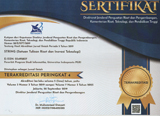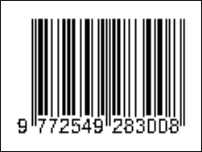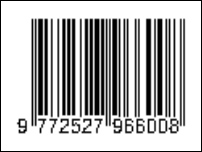Aplikasi Sistem Pakar untuk Mendiagnosa Penyakit ISPA menggunakan Metode Naive Bayes Berbasis Website
(1) Universitas Nasional
(2) Universitas Nasional
(3) Universitas Nasional
(*) Corresponding Author
Abstract
ISPA (Acute Respiratory Infection) is a disease that occurs due to respiratory tract disorders that can cause a variety of diseases ranging from asymptomatic illnesses, mild to severe infections due to environmental factors. The lack of public knowledge about the symptoms, how to treat it and how to overcome it result in a fairly high mortality rate due to ISPA. The expert system to be created is intended to make it easier a person to diagnose ISPA by adopting human knowledge into a computer system so the expert system is able to solve problems like an expert does. Expert system application is made using the Naive Bayesmethod because the Naive Bayesmethod is the best classification method with high probability when used in its system calculation. With this application, people will feel like they are consulting with a doctor or an expert who handles ISPA. This application is built based on websites that use the PHP programming language, Codeigniter framework and MySQL database. There are 104 training data and 39 testing data that have been tested. From 39 tests, there are 36 test data that are suitable and there are 3 test data that are not suitable. Accuracy obtained from the test is of 92.3%.
Keywords
Full Text:
PDFReferences
M. Marlina, W. Saputra, B. Mulyadi, B. Hayati, and J. Jaroji, Aplikasi sistem pakar diagnosis penyakit ispa berbasis speech recognition menggunakan metode naive bayes classifier, Digit. Zo. J. Teknol. Inf. dan Komun., vol. 8, no. 1, pp. 5870, 2017, doi: 10.31849/digitalzone.v8i1.629.
M. Bari, S. H. Sitorus, and U. Ristian, Implementasi Metode Naive Bayes Pada Aplikasi Prediksi Penyebaran Wabah Penyakit Ispa (Studi Kasus: Wilayah Kota Pontianak, vol. 06, no. 2338493X, pp. 205214, 2018.
Y. R. Nasution and Khairuna, Sistem pakar deteksi awal penyakit tuberkulosis dengan metode bayes, Klorofil, vol. 1, no. 1, pp. 1723, 2017.
R. SUDIARTO, Rancang Bangun Aplikasi Diagnosa Dini Terhadap Penyalagunaan Narkoba Menggunakan Metode Bayes Berbasis Web, J. Tek. Elektro, vol. 7, no. 01, pp. 4551, 2017.
M. Ilham Insani, A. Alamsyah, and A. T. Putra, Implementation of Expert System for Diabetes Diseases using Nave Bayes and Certainty Factor Methods, Sci. J. Informatics, vol. 5, no. 2, pp. 185193, 2018, doi: 10.15294/sji.v5i2.16143.
D. J. S. Sako and J. Palimote, A Medical Document Classification System for Heart Disease Diagnosis Using Nave Bayesian Classifier, Int. J. Appl. Sci. Math. Theory, vol. 4, no. 1, pp. 6979, 2018, [Online]. Available: www.iiardpub.org.
M. Nilashi, M. Z. Roudbaraki, M. Farahmand, L. Branch, and A. Branch, Journal of Soft Computing and Decision Support Systems A Predictive Method for Mesothelioma Disease Classification Using Nave Bayes Classifier, vol. 4, no. 6, pp. 814, 2017.
M. Syarief, N. Prastiti, and W. Setiawan, Comparison of Nave Bayes and Certainty Factor Method for Corn Disease Expert System: Case in Bangkalan, Indonesia, Int. J. Eng. Res. Appl. www.ijera.com, vol. 7, no. 11, pp. 3034, 2017, doi: 10.9790/9622-0711023034.
H. GKER, ocukluk a?? Dikkat Eksikli?i ve Hiperaktivite Bozuklu?unun ngrlmesine Ynelik Dinamik Uzman Sistem Tasar?m?, Bili?im Teknol. Derg., pp. 3341, 2019, doi: 10.17671/gazibtd.458102.
G. Singh, K. Bagwe, S. Shanbhag, S. Singh, and S. Devi, Heart disease prediction using Nave Bayes, Int. Res. J. Eng. Technol., vol. 4, no. 3, pp. 46, 2017, [Online]. Available: https://irjet.net/archives/V4/i3/IRJET-V4I3212.pdf.
Hartatik, A. Purnomo, R. Hartono, and H. Munawaroh, Nave Bayes Approach for Expert System Design of Children Skin Identification Based on Android, IOP Conf. Ser. Mater. Sci. Eng., vol. 333, no. 1, 2018, doi: 10.1088/1757-899X/333/1/012105.
A. Pattekari, S.A.; Parveen, Prediction system for heart disease using Nave Bayes, Int. J. Adv. Comput. Math. Sci., vol. 3, no. 3, pp. 290294, 2012.
E. Y. Rachmawati, B. Prasetiyo, and R. Arifudin, The Comparison between Bayes and Certainty Factor Method of Expert System in Early Diagnosis of Dengue Infection, Sci. J. Informatics, vol. 5, no. 2, pp. 159170, 2018, doi: 10.15294/sji.v5i2.15740.
Aristoteles, K. Adhianto, R. Andrian, and Y. N. Sari, Comparative analysis of cow disease diagnosis expert system using Bayesian network and Dempster-Shafer method, Int. J. Adv. Comput. Sci. Appl., vol. 10, no. 4, pp. 227235, 2019, doi: 10.14569/ijacsa.2019.0100427.
I. Candra Dewi, A. Andy Soebroto, and M. Tanzil Furqon, Sistem Pakar Diagnosa Penyakit Sapi Potong Dengan Metode Naive Bayes, J. Enviromental Eng. Sustain. Technol., vol. 2, no. 2, pp. 7278, 2015, doi: 10.21776/ub.jeest.2015.002.02.2.
Indonesia. Kementrian Kesehatan
Republik Indonesia.Direktorat Jenderal Pengendalian Penyakit dan Penyehatan Lingkungan.Pedoman pengendalian infeksi saluran pernapasan akut. Jakarta: Kementrian Kesehatan RI. 2011.
DOI: http://dx.doi.org/10.30998/string.v4i3.5441
Refbacks
Copyright (c) 2020 Fikry Ramadhana

This work is licensed under a Creative Commons Attribution 4.0 International License.
STRING (Satuan Tulisan Riset dan Inovasi Teknologi) indexed by:

Ciptaan disebarluaskan di bawah Lisensi Creative Commons Atribusi 4.0 Internasional.
View My Stats


 Sertifikat Akreditasi
Sertifikat Akreditasi
















